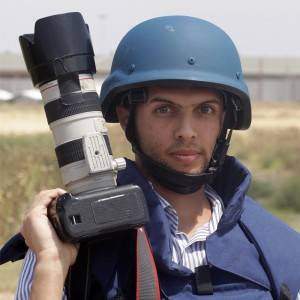“Soft Hands”, an exhibition held at the Stars Entertainment Centre by the beach in Gaza City, has been showcasing the traditional crafts and arts of the Palestinian people, many of whom rely on these traditional handicrafts to make a living and preserve their culture and identity.
Yara Al-Kafarneh, the exhibition’s coordinator and head of public relations, told MEMO that the exhibition aimed to promote a large segment of Gazan society, especially women looking to make a living in order to provide for their families. The exhibition is a place for them to exhibit their products and crafts, which vary from traditional embroidery, clothing, eastern and western foods, and also some imported clothing.
These exhibitions, along with other fairs that provide platforms for Gazans to showcase their crafts, are held to promote the culture of traditional Palestinian embroidery and arts. According to the organisers, these traditions are fighting to survive against Western notions of fashion and clothes that are currently predominant in Gazan society.
May Qwaider, who supports a family of seven and exhibits her embroideries, told MEMO that she owns her own shop where she sells unique textiles and patterns. However, May also participates in exhibitions like “Soft Hands” in order to promote the Palestinian culture through her embroidery,as well as to maintain the Palestinian identity.
Her embroideries are an additional source of income, as those attending the exhibition purchase her pieces, as well as the works created by other craftsmen and women.
Working in this traditional art requires a lot of time, patience and talent, as a needle and thread is used in order to craft each individual item. May produces five pieces a month, ranging from dresses, wallets, and other embroidered souvenirs.
The art of Palestinian embroidery is kept alive by artisans like May and the others who attend these exhibitions. These artists hope that, through displaying their work at exhibitions and fairs for all to see, they may preserve their Palestinian heritage and identity that has for so long been under threat due to Israeli occupation.
The views expressed in this article belong to the author and do not necessarily reflect the editorial policy of Middle East Monitor.


![2017_1_16-exhibition-held-at-the-Stars-Entertainment-Centre--1 Stars Entertainment Centre by the beach in Gaza City [Mohammed Asad/Middle East Monitor]](https://i0.wp.com/www.middleeastmonitor.com/wp-content/uploads/2017/01/2017_1_16-exhibition-held-at-the-Stars-Entertainment-Centre-1.jpg?w=610&h=407&ssl=1)
![2017_1_16-exhibition-held-at-the-Stars-Entertainment-Centre--2 Stars Entertainment Centre by the beach in Gaza City [Mohammed Asad/Middle East Monitor]](https://i0.wp.com/www.middleeastmonitor.com/wp-content/uploads/2017/01/2017_1_16-exhibition-held-at-the-Stars-Entertainment-Centre-2.jpg?w=302&h=202&ssl=1)
![2017_1_16-exhibition-held-at-the-Stars-Entertainment-Centre-3 Stars Entertainment Centre by the beach in Gaza City [Mohammed Asad/Middle East Monitor]](https://i0.wp.com/www.middleeastmonitor.com/wp-content/uploads/2017/01/2017_1_16-exhibition-held-at-the-Stars-Entertainment-Centre-3.jpg?w=302&h=201&ssl=1)
![2017_1_16-exhibition-held-at-the-Stars-Entertainment-Centre-4 Stars Entertainment Centre by the beach in Gaza City [Mohammed Asad/Middle East Monitor]](https://i0.wp.com/www.middleeastmonitor.com/wp-content/uploads/2017/01/2017_1_16-exhibition-held-at-the-Stars-Entertainment-Centre-4.jpg?w=303&h=202&ssl=1)
![2017_1_16-exhibition-held-at-the-Stars-Entertainment-Centre-5 Stars Entertainment Centre by the beach in Gaza City [Mohammed Asad/Middle East Monitor]](https://i0.wp.com/www.middleeastmonitor.com/wp-content/uploads/2017/01/2017_1_16-exhibition-held-at-the-Stars-Entertainment-Centre-5.jpg?w=303&h=202&ssl=1)
![2017_1_16-exhibition-held-at-the-Stars-Entertainment-Centre--6 Stars Entertainment Centre by the beach in Gaza City [Mohammed Asad/Middle East Monitor]](https://i0.wp.com/www.middleeastmonitor.com/wp-content/uploads/2017/01/2017_1_16-exhibition-held-at-the-Stars-Entertainment-Centre-6.jpg?w=302&h=202&ssl=1)
![2017_1_16-exhibition-held-at-the-Stars-Entertainment-Centre--7 Stars Entertainment Centre by the beach in Gaza City [Mohammed Asad/Middle East Monitor]](https://i0.wp.com/www.middleeastmonitor.com/wp-content/uploads/2017/01/2017_1_16-exhibition-held-at-the-Stars-Entertainment-Centre-7.jpg?w=302&h=202&ssl=1)
![2017_1_16-exhibition-held-at-the-Stars-Entertainment-Centre--8 Stars Entertainment Centre by the beach in Gaza City [Mohammed Asad/Middle East Monitor]](https://i0.wp.com/www.middleeastmonitor.com/wp-content/uploads/2017/01/2017_1_16-exhibition-held-at-the-Stars-Entertainment-Centre-8.jpg?w=302&h=201&ssl=1)
![2017_1_16-exhibition-held-at-the-Stars-Entertainment-Centre--10 Stars Entertainment Centre by the beach in Gaza City [Mohammed Asad/Middle East Monitor]](https://i0.wp.com/www.middleeastmonitor.com/wp-content/uploads/2017/01/2017_1_16-exhibition-held-at-the-Stars-Entertainment-Centre-10.jpg?w=610&h=407&ssl=1)
![2017_1_16-exhibition-held-at-the-Stars-Entertainment-Centre--11 Stars Entertainment Centre by the beach in Gaza City [Mohammed Asad/Middle East Monitor]](https://i0.wp.com/www.middleeastmonitor.com/wp-content/uploads/2017/01/2017_1_16-exhibition-held-at-the-Stars-Entertainment-Centre-11.jpg?w=456&h=304&ssl=1)
![2017_1_16-exhibition-held-at-the-Stars-Entertainment-Centre--12 Stars Entertainment Centre by the beach in Gaza City [Mohammed Asad/Middle East Monitor]](https://i0.wp.com/www.middleeastmonitor.com/wp-content/uploads/2017/01/2017_1_16-exhibition-held-at-the-Stars-Entertainment-Centre-12.jpg?w=456&h=304&ssl=1)






